Industrial Off-Grid Solar Solutions
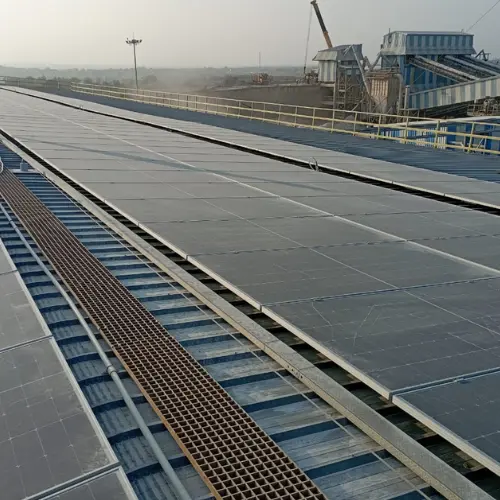
Synergy Solar is a leading EPC company for industrial solar solutions. Industries across India are increasingly adopting standalone solar energy systems to achieve energy independence, reduce operational costs, and enhance sustainability. Our industrial off-grid solar systems operate independently from the utility grid, delivering a reliable and continuous power supply, especially in remote or off-grid locations.
These systems are ideal for energy-intensive sectors such as textiles, manufacturing, logistics, IT hubs, and commercial complexes. By leveraging solar power for factories, industries can significantly cut down electricity expenses, mitigate the risks associated with grid unreliability, and contribute to environmental conservation.
How Industrial Off-Grid Solar Systems Work
An off-grid solar energy system comprises several key components that work in harmony to provide uninterrupted power:
Solar PV Panels: Capture sunlight and convert it into direct current (DC) electricity.
Inverter: Converts DC electricity into alternating current (AC) to power industrial machines.
Battery Storage: Stores excess energy for use during periods of low sunlight or high demand.
Grid Backup: The system can also pull from the grid during high-demand periods, ensuring operational continuity.
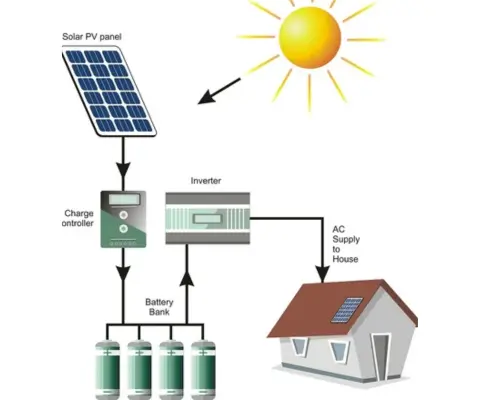
Benefits of Industrial Off-Grid Solar Systems
Energy Independence
- Eliminates reliance on the utility grid, providing a self-sufficient power source.
- Ideal for industries in remote areas or regions with unreliable grid infrastructure.
Reduced Operational Costs
- Significantly lowers electricity bills by using free solar energy.
- Reduces or eliminates the need for diesel generators, leading to savings on fuel and maintenance.
Environmental Sustainability
- Contributes to reducing the carbon footprint by decreasing dependence on fossil fuels.
- Supports corporate social responsibility (CSR) initiatives and compliance with environmental regulations.
Scalability and Flexibility
- Systems can be scaled to meet the growing energy demands of expanding industrial operations.
- Modular design allows for easy upgrades and integration with existing infrastructure.
Reliable Power Supply
- Ensures continuous power availability, even during grid outages or in off-grid locations.
- Enhances the reliability of critical industrial processes and operations.
Key Components of Industrial Off-Grid Solar Systems
Industrial Solar Panels (PV Modules)
- High-efficiency monocrystalline or polycrystalline modules with a lifespan of 25+ years.
- Designed to withstand dust, temperature variation, and industrial pollution.
- Essential for solar power for factories and large warehouses.
Solar Inverters (Off-Grid / Hybrid Inverters)
- Converts DC from panels and batteries into AC power for heavy industrial machinery.
- Provides smart load management, ensuring stable voltage and frequency.
- Modern inverters in 2025 include IoT-enabled monitoring for factories and IT parks.
Battery Storage System
- Deep-cycle lithium-ion or lead-acid industrial batteries.
- Stores solar power for nighttime and backup during outages.
- Critical for industries in remote areas without reliable grid access.
Charge Controllers (MPPT Technology)
- Protects batteries from overcharging and ensures optimal charging efficiency.
- Extends battery life, especially under heavy industrial usage.
Monitoring & Control Systems
- Smart dashboards track energy generation, storage, and consumption in real time.
- Alerts for underperformance or equipment faults enable proactive maintenance.
- Many industries now use SCADA-based solar monitoring systems for precision control.
Applications of Off-Grid Solar Systems in Industry
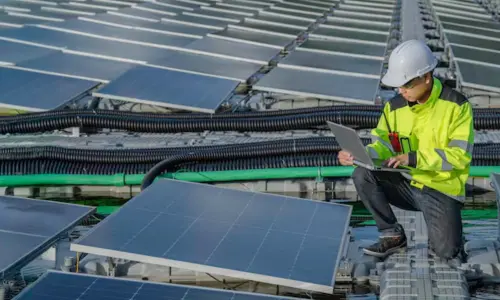
Manufacturing Facilities
Powering machinery and production lines, reducing downtime, and ensuring consistent operation.
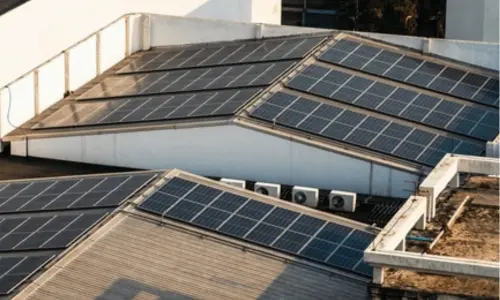
Warehouses & Logistics Parks
Supplying energy for lighting, HVAC systems, and automated processes.

Data Centers & IT Facilities
Providing a stable power source to maintain 24/7 operations and prevent data loss.
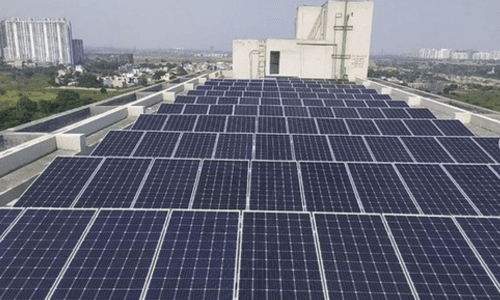
Remote Industrial Parks & Commercial Complexes
Delivering energy to areas without access to the central grid, supporting local economies.
Challenges of Industrial Off-Grid Solar Systems
High Initial Investment
Industrial off-grid solar systems require substantial upfront costs for solar panels, inverters, and battery storage. However, financial support like solar loans and subsidies makes them more affordable in 2025.
Battery Replacement & Maintenance
Unlike grid-tied systems, off-grid solar heavily depends on batteries. Industrial-grade batteries need replacement every 8–12 years, increasing long-term costs.
Energy Storage Costs
Batteries account for 30–40% of total project costs. With rising lithium-ion prices, industries need smart sizing and energy-efficient equipment to optimize costs.
Space Requirement
Large-scale industrial off-grid solar projects (e.g., 1 MW) demand 4–5 acres of land or 1,00,000 sq. ft. of rooftop, plus dedicated battery storage rooms.
Financing Options for Industrial Off-Grid Solar Projects in India
- Bank & Financial Institution Loans: Reflects 2025 industrial solar financing trends with typical coverage (70–90%), interest rates (7–10%), and tenure (5–10 years).
- Solar-Specific Loan Programs: Includes CreditSucess, SBI, ICICI, IDBI, and PNB schemes that are active in 2025.
- Central & State Government Support: Mentions CLSS and MNRE-approved programs, which are currently applicable for industrial off-grid solar projects.
- Advantages: Accurately reflects benefits relevant today, including cost reduction, faster ROI, and eligibility for AD/CFA.
Why Choose Us for Industrial Off-Grid Solar Solutions
Sustainability Commitment
Commitment to helping industries achieve long-term energy independence and environmental goals.
Proven Expertise
Proven experience in designing and implementing large-scale off-grid solar projects for industries.
Premium Technology
Utilization of Tier-1 solar panels and industrial-grade inverters to ensure system reliability and longevity.
Custom Engineering
Tailored solutions to meet the specific energy needs and operational requirements of your facility.
End-to-End Support
Comprehensive services from initial consultation and design to installation and ongoing maintenance.
Frequently Asked Questions
What is the lifespan of an industrial off-grid solar system?
Solar panels typically last 25–30 years, while batteries may require replacement every 8–12 years, depending on usage and maintenance.
Can my industry operate during power outages?
Yes, the battery storage system ensures continuous power supply even during grid outages.
How much space is required for a 500 kW off-grid solar system?
Approximately 50,000–70,000 sq. ft. of rooftop or 1–2 acres for ground-mounted panels, plus space for battery storage.
Are subsidies available for off-grid industrial solar systems?
Yes, incentives like Accelerated Depreciation, Central Financial Assistance, GST Input Credit, and state-specific subsidies apply.
What is the return on investment (ROI) for an industrial off-grid solar system?
ROI is typically achieved in 4–6 years, depending on energy consumption and diesel savings.
